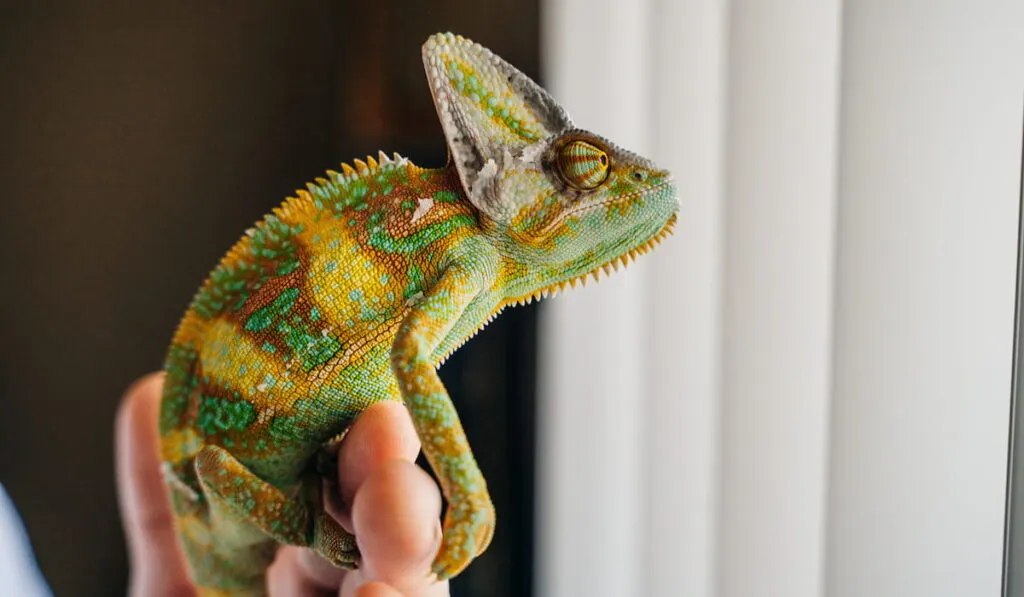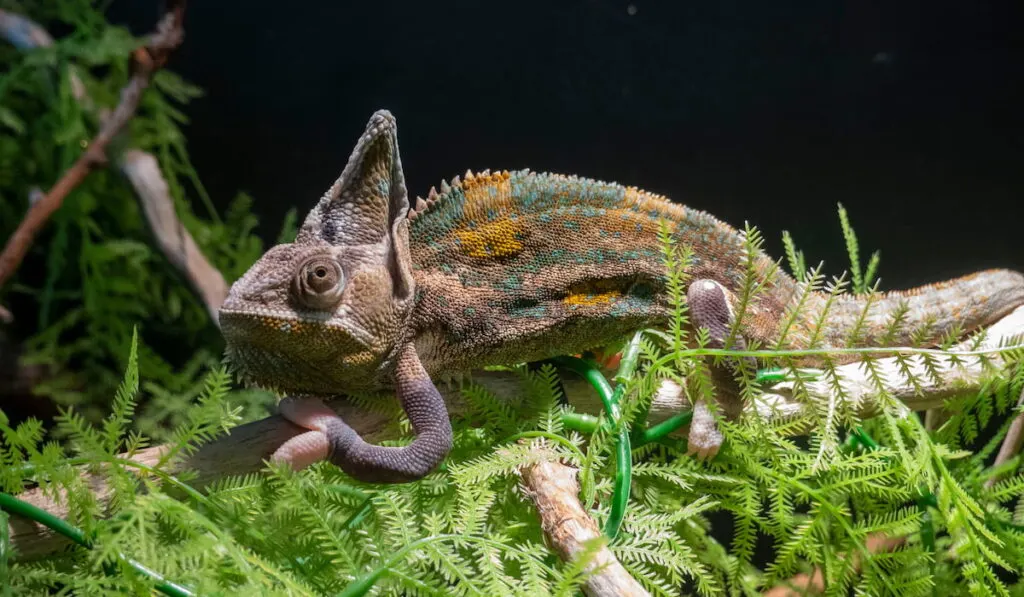Veiled Chameleons originated in Saudi Arabia and are commonly found in jungles and forests in the Africa and the Amazon.
Popular to contrary belief, chameleons do not change to all colors of the rainbow.
For example, it is widely believed that if you put a chameleon(of any kind) on a red sweater it will grow into a bright red color in order to blend in and be invisible from predators.

The truth is, a chameleon’s color changes based on a change in their body temperature to adjust to a warmer or colder climate.
This may also be a cause of signaling intentions to other chameleons.
| Veiled Chameleon color | What it means |
| Bright /light green | Happy, comfortable, a cool temperature |
| Dark green | Stressed, overwhelmed, a warmer temperature |
| Spotted green | In a stressful situation, uncomfortable |
| Black | Trying to become warm or showing illness |
Table of Contents
What colors can chameleons be?
It is known that chameleons can be a wide variety of colors, however, there are misconceptions and important symptoms to look at when seeing the color of your chameleon.
These most common colors are not dependent on age or sex, however the females may be a more dull color from juvenile to adulthood.
Bright green

Chameleons are smart creatures, they are highly self-aware and specifically knowledgeable of their own body temperature.
Since this is the case, chameleons use their skin color to control this.
For example, if a chameleon is cold, its skin color will become a deeper green in an attempt to warm up.
When a chameleon is warm they will turn bright green in attempts to cool off to a temperature more comfortable to them.
In addition to temperature, a chameleon will produce a bright green color to the viewer when feeling calm, happy, and laid back.
Dark green
When a chameleon turns dark green, this may be a strong indicator that they are stressed, feeling overwhelmed, or unhappy.
This often happens when being held for too long or when in a new and unfamiliar environment.
Another factor may be temperature, if a chameleon is feeling cold they will turn their body color shade a dark green in order to regulate their body temperature.
It is important to know that a dark green color, in addition to discomfort may be an indicator of anger, when this is the case it is best to put them back into their cage/ habitat and leave them be for a few minutes to let them calm down and relax.
Spotted green

A chameleon may turn a spotted green at times with both light and dark greens.
In some cases there could be spots of light blue or bright gold.
When this occurs it means that it could be angry, stressed out, or unhappy, much like when dark green, this indicates their condition and their mood.
Seeing this means you should allow your chameleon some space and let them relax for a while before trying to interact/hold them again.
Black
When a chameleon turns black, or a very dark brown it could mean a couple of things.
One of the main things is when your chameleon is very close to their heat lamp they are trying to absorb heat and become warm.
If out of the cage either in someone’s hand or a new environment this may indicate very high levels of stress, much like being a dark green color.
In some cases, if a chameleon is bright black with little movement and little sign of trying to change color or looking around it may be a sign of illness or being close to death.
It is very important to take your chameleon to the vet if this is the case!
Do color changes indicate mood?

The color of a chameleon does indicate their mood, and tells the owner about the health and personality of their friend.
As mentioned above, the different color of the chameleon indicates whether they are happy, upset or uncomfortable.
These colors reflect how they feel. This is good to know and is unique to the chameleon and not many other animals!
How do veiled chameleons change color?
A popular misconception is that a veiled chameleon changes their color through dispersing their pigments throughout their body in order to change to their desired color, however it is actually based off of the light reflecting off of their skin.
These amazing animals can create a change in color in about 20 seconds depending on the situation, and temperature.
The scientific reason is the deep layer known as the guanine nanocrystals, a crystal found deep within their skin. (source)
When needing/wanting to change color these crystals move around either rapidly or slowly.
This changes the wavelengths of light, thus creating the color that is seen.
Do males and females have different colors

Male and female chameleons may produce different colors.
Male chameleons tend to be a brighter and more vibrant color with potential hints of blue, gold, and yellow.
However the females may be a more dull color with different shades of green.
Males often show strong pigmentation and aggressive coloring because of their genetics.
Females have this ability as well but are less likely to do so in general especially when attempting to impress other chameleons.
Important note
This information is not a supplement for medical attention.
If you believe your chameleon, no matter what age or type is ill or has any abnormal symptoms it is important to take your pet in to seeing a vet right away.
Taking the steps to care for your friend is important and vital for him to achieve a full and healthy life!
Sources
- https://www.wired.com/2014/04/how-do-chameleons-change-colors/
- https://www.everythingreptiles.com/veiled-chameleon/
- https://www.thedodo.com/why-chameleons-change-color–1541739423.html
- https://chamownersweb.net/husbandry/care_sheet_veiled.htm
- https://www.quora.com/Why-does-my-pet-Chameleon-keep-turning-black
- https://www.scientificamerican.com/article/the-secret-to-chameleons-ability-to-change-color
- https://oddlycutepets.com/how-fast-do-chameleons-change-colors/
- https://www.everythingreptiles.com/veiled-chameleon/
- https://mypetchameleon.com/general/differences-in-sexes/
